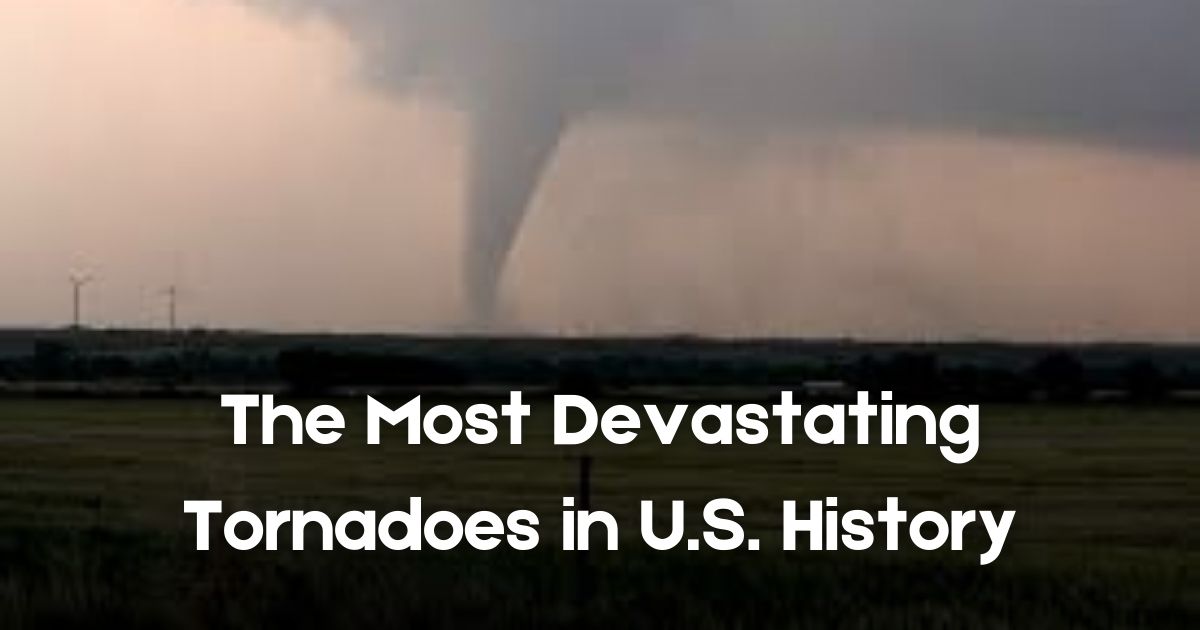
Tornadoes are one of nature’s most powerful and dangerous forces. With spinning winds that can reach speeds of over 200 miles per hour, tornadoes can tear through towns, destroy homes, and change lives in just a few minutes. In the United States, tornadoes are most common in an area known as “Tornado Alley,” which includes parts of Texas, Oklahoma, Kansas, Nebraska, and other nearby states. However, tornadoes can, and do, happen in nearly every state, affecting communities across the country.
This article covers some of the most devastating tornadoes in U.S. history. Each of these storms caused massive destruction, loss of life, and left lasting scars on the people and places impacted.
1. The Tri-State Tornado (1925)
Date: March 18, 1925
States Affected: Missouri, Illinois, Indiana
Fatalities: 695
Injuries: Over 2,000
Estimated Damage: Approximately $17 million in 1925 (over $260 million today)
The Tri-State Tornado is still the deadliest tornado in U.S. history. This massive storm touched down in Missouri before tearing across Illinois and Indiana, traveling over 200 miles in just a few hours. This tornado left a path of destruction over a mile wide in some places and completely destroyed entire towns, including Murphysboro, Illinois.
The Tri-State Tornado moved quickly, which made it especially deadly because people did not have time to escape. At the time, there were no modern tornado warning systems, and people didn’t have access to weather radios or smartphones to alert them of the coming storm. This tornado taught the country just how dangerous these storms could be, leading to new efforts to understand and predict tornadoes.
2. The Great Natchez Tornado (1840)
Date: May 7, 1840
Location: Natchez, Mississippi
Fatalities: 317
Injuries: Hundreds
Estimated Damage: Unknown, but significant for the time
The Natchez Tornado is one of the earliest and deadliest tornadoes recorded in U.S. history. This tornado struck the town of Natchez along the Mississippi River and caught many people by surprise. At that time, there was no way to warn people about approaching tornadoes, and because it happened so long ago, there are few records of the damage and exact path.
Most of the people killed were on the river itself or near the riverfront. Boats on the river were capsized, and buildings along the shore were flattened. The impact of this tornado was devastating, particularly for the era. It remains one of the few tornadoes in U.S. history with a death toll over 300.
3. The St. Louis-East St. Louis Tornado (1896)
Date: May 27, 1896
Location: St. Louis, Missouri, and East St. Louis, Illinois
Fatalities: 255
Injuries: Around 1,000
Estimated Damage: Approximately $10 million in 1896 (over $300 million today)
The St. Louis-East St. Louis Tornado is one of the deadliest tornadoes ever to hit a major U.S. city. This tornado crossed the Mississippi River from St. Louis into East St. Louis, leaving a trail of destruction through both cities. Many people were killed by flying debris, collapsing buildings, and fires that broke out after the tornado passed.
St. Louis was a growing city at the time, and many people lived in crowded neighborhoods. The tornado’s timing in the evening made it even more deadly, as many families were at home. The widespread destruction caused millions of dollars in damage and disrupted the lives of thousands of people in both Missouri and Illinois.
4. The Tupelo Tornado (1936)
Date: April 5, 1936
Location: Tupelo, Mississippi
Fatalities: 216
Injuries: Around 700
Estimated Damage: Unknown
The Tupelo Tornado struck the city of Tupelo in Mississippi, tearing through neighborhoods and causing widespread destruction. It hit in the evening when many people were home with their families. This tornado left a lasting impact on the city, with entire neighborhoods reduced to rubble.
One notable story from the Tupelo Tornado is that a young boy named Elvis Presley, who would later become one of the most famous singers in the world, survived the storm. The impact of this tornado led to increased efforts to study and understand tornadoes, eventually leading to the development of tornado warning systems that are still used today.
5. The Gainesville Tornado (1936)
Date: April 6, 1936
Location: Gainesville, Georgia
Fatalities: 203
Injuries: Over 1,600
Estimated Damage: Around $13 million in 1936
Just one day after the Tupelo Tornado, another deadly tornado struck the city of Gainesville, Georgia. This tornado was actually a pair of tornadoes that touched down simultaneously, tearing through the downtown area. The twin tornadoes destroyed factories, shops, and homes, leaving parts of the city in ruins.
Because the tornado hit during the daytime, many people were at work in factories and other buildings. Tragically, the tornado killed more than 200 people and injured over 1,600, making it one of the deadliest tornadoes in U.S. history. The Gainesville Tornado highlighted the need for better building safety standards and improved warning systems to prevent similar tragedies in the future.
6. The Joplin Tornado (2011)
Date: May 22, 2011
Location: Joplin, Missouri
Fatalities: 158
Injuries: Over 1,100
Estimated Damage: Around $2.8 billion
The Joplin Tornado is one of the most recent and devastating tornadoes in modern U.S. history. This EF-5 tornado, the strongest rating on the Enhanced Fujita scale, hit the city of Joplin, Missouri, causing incredible destruction. With winds over 200 miles per hour, it flattened entire neighborhoods, destroyed hospitals and schools, and caused billions of dollars in damage.
Despite advanced weather technology and warning systems, the Joplin Tornado caused a high number of fatalities and injuries. This tornado showed the challenges of preparing for such a powerful storm, even with modern systems in place. The Joplin community faced a long and difficult recovery, with people across the nation coming together to support the city.
7. The New Richmond Tornado (1899)
Date: June 12, 1899
Location: New Richmond, Wisconsin
Fatalities: 117
Injuries: Around 200
Estimated Damage: Significant for the time
The New Richmond Tornado struck the small town of New Richmond in Wisconsin on a summer evening. A large circus was in town, and many people had gathered in the downtown area to celebrate. When the tornado hit, it destroyed much of the town center, leaving debris and chaos in its path.
Because of the crowded downtown area, the tornado caused a high number of casualties and injuries, making it one of the deadliest tornadoes in the northern United States. The New Richmond Tornado serves as a reminder that tornadoes can happen almost anywhere, even in states not typically known for tornadoes.
8. The Flint-Beecher Tornado (1953)
Date: June 8, 1953
Location: Flint, Michigan
Fatalities: 116
Injuries: Over 800
Estimated Damage: Around $19 million in 1953
The Flint-Beecher Tornado struck the area of Flint, Michigan, causing widespread destruction and leaving dozens dead. This tornado struck in the evening, making it harder for people to see it coming. It left a path of destruction nearly a mile wide, destroying homes, schools, and businesses.
This tornado led to the development of the first tornado warning systems. Until then, people had little to no warning when a tornado was approaching. The Flint-Beecher Tornado was a wake-up call for communities across the United States to improve preparedness and safety measures.
Conclusion
These tornadoes represent some of the most devastating events in U.S. history, each one leaving behind a legacy of destruction, loss, and resilience. From early tornadoes like the Natchez and St. Louis tornadoes to recent disasters like the Joplin Tornado, each storm has taught valuable lessons about the importance of preparedness, safety, and community support.
While tornadoes are unpredictable and often dangerous, advances in technology, warning systems, and building standards have helped reduce the risks and save lives. Today, people are better informed and more prepared, but the stories of these past tornadoes continue to remind us of the power of nature and the importance of being ready.
For those living in tornado-prone areas, understanding these historic storms can help increase awareness and motivate people to take action to stay safe. The most devastating tornadoes in U.S. history show both the dangers of these powerful storms and the resilience of the communities that have faced them.






